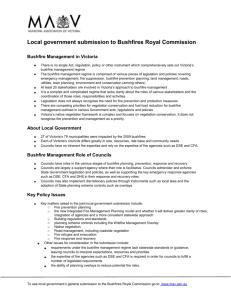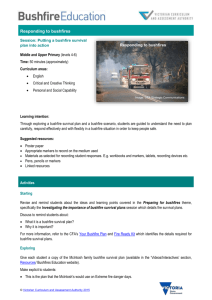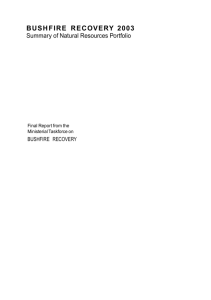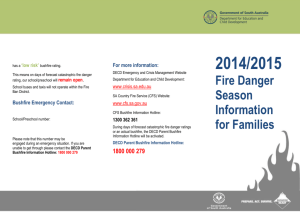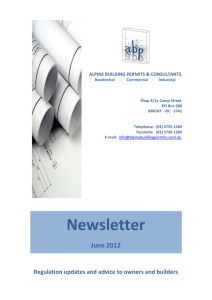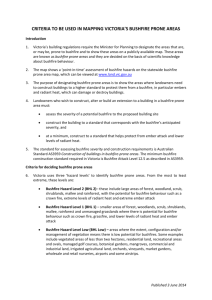section five: defending your property
advertisement
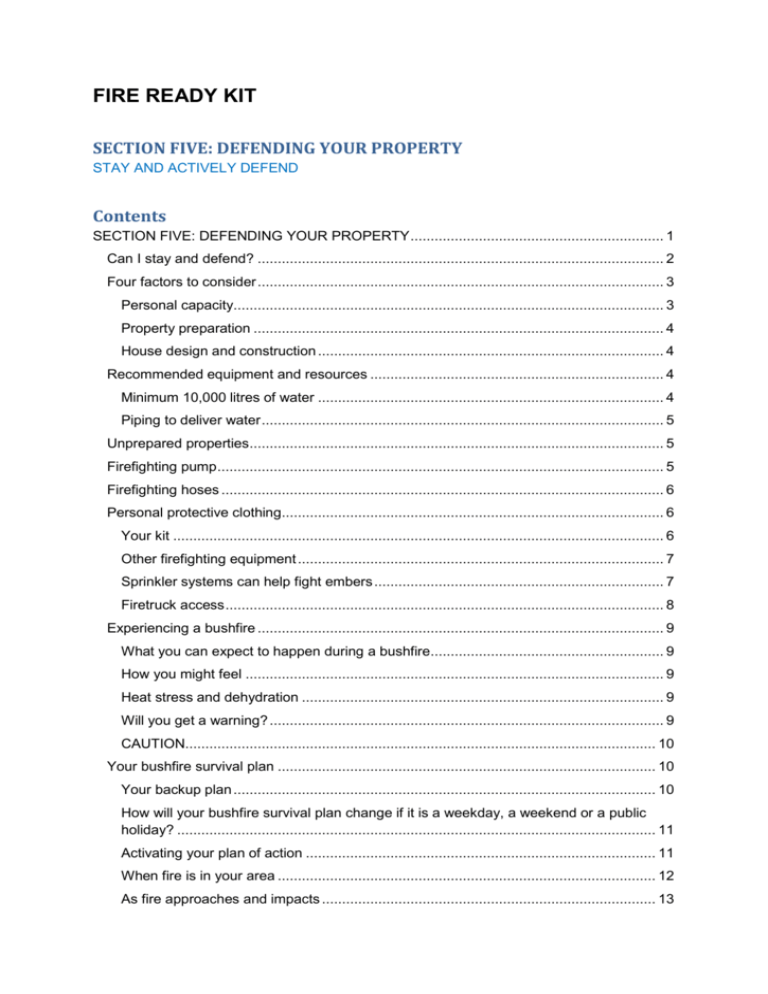
FIRE READY KIT SECTION FIVE: DEFENDING YOUR PROPERTY STAY AND ACTIVELY DEFEND Contents SECTION FIVE: DEFENDING YOUR PROPERTY ............................................................... 1 Can I stay and defend? ..................................................................................................... 2 Four factors to consider ..................................................................................................... 3 Personal capacity........................................................................................................... 3 Property preparation ...................................................................................................... 4 House design and construction ...................................................................................... 4 Recommended equipment and resources ......................................................................... 4 Minimum 10,000 litres of water ...................................................................................... 4 Piping to deliver water .................................................................................................... 5 Unprepared properties....................................................................................................... 5 Firefighting pump ............................................................................................................... 5 Firefighting hoses .............................................................................................................. 6 Personal protective clothing............................................................................................... 6 Your kit .......................................................................................................................... 6 Other firefighting equipment ........................................................................................... 7 Sprinkler systems can help fight embers ........................................................................ 7 Firetruck access ............................................................................................................. 8 Experiencing a bushfire ..................................................................................................... 9 What you can expect to happen during a bushfire.......................................................... 9 How you might feel ........................................................................................................ 9 Heat stress and dehydration .......................................................................................... 9 Will you get a warning? .................................................................................................. 9 CAUTION..................................................................................................................... 10 Your bushfire survival plan .............................................................................................. 10 Your backup plan ......................................................................................................... 10 How will your bushfire survival plan change if it is a weekday, a weekend or a public holiday? ....................................................................................................................... 11 Activating your plan of action ....................................................................................... 11 When fire is in your area .............................................................................................. 12 As fire approaches and impacts ................................................................................... 13 If your house catches fire ............................................................................................. 13 After the fire ................................................................................................................. 14 Animals and bushfire ....................................................................................................... 14 Pets ............................................................................................................................. 14 Horses ......................................................................................................................... 14 Livestock ...................................................................................................................... 15 Bushfires and radiant heat ............................................................................................... 15 Radiant heat is the biggest killer in a fire ...................................................................... 15 Protection from radiant heat ......................................................................................... 15 Shield yourself from radiant heat .................................................................................. 16 Heat-related illness ...................................................................................................... 16 Look after your emotional health after a fire ................................................................. 17 Need some help? Visit cfa.vic.gov.au Call the Victorian Bushfire Information Line on 1800 240 667 or via National Relay Service on 1800 555 677 Defending a house requires at least two able-bodied, fit and determined adults who are physically and mentally prepared to work in arduous and difficult conditions. Defending your home is risky – you could be seriously injured, suffer psychological trauma or die. The safest option is to be well away from the threat. Do not expect a firetruck to help you defend your home. Can I stay and defend? In high-risk areas, leaving early is your only safe option on Code Red days. Do not wait and see. Know your trigger to leave – make a decision about when you will leave, where you will go, how you will get there, when you will return and what you will do if you cannot leave. Houses are not designed or constructed to withstand fires in Code Red conditions. Most house losses occur on days of Code Red conditions. Defending your home is very risky. You could be seriously injured or die. Only consider staying with your property on Extreme or Severe days if you are fully prepared and can actively defend your home. Defending a house requires at least two able-bodied, fit and determined adults who are physically and mentally prepared to work long and hard in arduous and difficult conditions. If you are not prepared to the highest level, leaving high-risk bushfire areas early is your safest option. Remember Even people who are extremely well prepared can die fighting fires at their home. The best way to survive a bushfire is to be away from the threat. A bushfire can destroy your house even if your house is bushfire ready. People get hurt and die in bushfires. Survival must be your main priority. Many houses in high-risk bushfire areas are not built to withstand bushfire. Defending your home is risky and complex. Four factors to consider There are four important factors to consider when planning to defend your property: Personal capacity Property preparation House design and construction Recommended equipment and resources Personal capacity Defending your home will be extremely hard work and requires significant resources. It may take hours and sometimes days of extreme effort. Children, the elderly, and people with special needs or a disability should be well away from the threat. If you stay and defend your house it will be: scary physically and mentally tiring hard to see hard to breathe very noisy very hot. Do not stay and defend if you have: asthma a heart problem other illness/disability. Do not stay and defend if you are with a person who: has a physical disability has an intellectual disability has emotional or mental health problems is sick is elderly is a child less than 16 years old. Property preparation Section 3 (Your Property: How prepared is it?) of this kit outlines what is required to prepare your property before the fire season. No matter how well you prepare, if you live in a high-risk area your home may not be defendable on Extreme or Severe fire risk days. In these areas your home will not be defendable on a Code Red day. CFA recommends that residents planning to stay and defend book a free Home Bushfire Assessment. Call the Victorian Bushfire Information Line on 1800 240 667 or via National Relay Service on 1800 555 677. House design and construction How well your house is constructed and designed plays a big part in how it will withstand a fire. CFA and the Building Commission have produced a guide to better prepare your home. Download A Guide to Retrofit your Home for Better Protection from a Bushfire from cfa.vic.gov.au Recommended equipment and resources If you are confident you are capable and prepared to actively defend your property, CFA recommends you have these resources and equipment as a minimum: 10,000 litres of water for firefighting purposes. Many houses in the Black Saturday fires used more than 40,000 litres. A firefighting pump that is protected from radiant heat and not reliant on mains power supply. Firefighting hoses that reach around your home. Protective clothing. Minimum 10,000 litres of water You should have access to a dedicated, independent water supply of at least 10,000-litres to stay to actively defend. You cannot rely on mains water during a bushfire. If you can, install a 10,000 litre tank specifically for firefighting purposes. Alternatively, the 10,000 litres could be made up from a variety of sources such as several tanks or a dam and a tank or a swimming pool. Remember, dams can dry up over summer so it is important to identify other alternate water sources on or near your property. Tanks should be made from galvanised iron or concrete. Plastic tanks can melt or fail in extreme bushfires. If you have a tank it is extremely important that you protect it from the effects of fire by removing vegetation around it. Make sure you can access this water easily and that it is located close to the buildings you need to protect. You can also store smaller amounts of water using: 44-gallon drums placed strategically around the house rubbish bins (wheelie bins work well but could melt in intense heat) wheelbarrows troughs or garden ponds. Piping to deliver water You must also consider the type of piping used if you have a tank. It is recommended that all below-ground water pipelines must be installed to the following depths: Subject to vehicle traffic, 300 millimetres. Under houses or concrete slabs, 75 millimetres. All other locations, 225 millimetres. All fixed above-ground water pipelines and fittings, including water supply, must be constructed of non-corrosive and non-combustible materials. Above-ground water supplies should be provided with a CFA fitting. To make this a useful system it is best to have a ‘T’ fitting that allows one side for CFA and the other side for you. CFA’s specifications for this type of fitting are: one 64 millimetre, three thread/25 millimetre x 50 millimetre nominal bore British Standard Pipe (BSP), round male coupling (see below) all pipe work and valving between the water supply and the outlet must be no less than 50 millimetre nominal bore if less than 20 metres from the building, each outlet must face away from the building to allow access during emergencies. Unprepared properties Staying with an unprepared property is very dangerous and could cost you your life. If you have not prepared your property before the fire season you should leave before bushfire threatens. Firefighting pump Have a petrol, diesel or electric pump if you need to draw water from an independent water supply, such as a tank or swimming pool. If you have an electric water pump, you will need to have a generator as backup. It is likely that mains power will fail during a bushfire. The generator must have adequate capacity to start and run the electric pump. Always test your equipment to ensure it works the way you want it to. The size of the pump you will need depends on: the source of water and how far away it is piping size, length and configuration the number of outlets you will be using at the same time the size and length of the hoses you are using with your pump. Pump suppliers should be able to advise you of the size of pump you require. When a pump overheats or melts it stops working. If the fuel in the pump vaporises from the heat it will become inoperable. It is extremely important that your pump is protected from fire and radiant heat. You can protect your pump by: removing the vegetation around it housing it in a shed or another building that will resist radiant heat, direct flame contact, embers and has adequate ventilation. The more protection you can give your pump the more likely it will continue to operate during a bushfire. It is important that every adult in the household knows how to start and operate the pump. You need to have plenty of fuel to keep the pump running during a fire. The fuel in the pump must be changed annually. Stale fuel may prevent your pump from working properly. You must plan what you will do if your pump fails during a bushfire. You may consider having a second pump as a backup. Test your pump regularly to ensure it operates the way you want it to. Firefighting hoses The standard garden hose is made from plastic and may melt in a bushfire. CFA suggests using fire-resistant hoses in place of garden hoses. Keep in mind that the bigger the hose the heavier it will become when full of water and the greater the volume of water used. Consider: Hoses will need to reach to all areas of your home. You can use a string line to work out the required hose lengths. Metal hose fittings for taps are less likely to melt when temperatures rise. Put a hose fitting connection on to your washing machine tap so that you can use your hose inside if needed. Personal protective clothing Put together a kit of clothing for each household member. You must cover all exposed skin to protect yourself from radiant heat and embers. Change into these clothes as soon as you are aware of fire in your area. Remember, personal protective clothing can only protect you from low levels of radiant heat. Your kit A wide-brimmed hat to protect your head. Eye protection such as smoke goggles to shield your eyes. A ‘P2’ type mask or cotton scarf /handkerchief for face protection and to filter smoke. A long-sleeved, collared shirt and pants made from cotton or some other natural fibre. Tough leather garden gloves – not rubber or synthetic. Sturdy boots and wool or cotton socks. Other firefighting equipment The equipment recommended on pages 6 and 7 is extremely important. But there is also a range of other equipment to assist you in defending your property. Many of these items are commonly found around the home. Consider the following: Buckets – Galvanised buckets are best as plastic buckets can melt. Mops – Old-fashioned, cotton-headed mops soaked with water can be used to put out embers. Ladders – Sturdy ladders will be required to check the ceiling space and roof for embers. Blankets and towels – Made from wool or cotton only. When wet they can be used to seal any gaps under doors. This helps prevent embers and smoke from entering the house. Torches – Battery-powered or wind-up. Leave a torch in the roof space to check for embers. Have another in the house for when the power goes off during the bushfire. Make sure you have plenty of batteries available. Radio – Battery-powered or wind-up. Tune into ABC local radio, commercial radio stations and designated community radio stations to receive updated fire information. Power will most likely go out. Have extra batteries handy. Shovels and rakes – These can be very useful for shovelling dirt onto embers or small fires and to break up piles of burning material. Knapsacks and water sprayers – Firefighting knapsacks can be purchased. Consider how heavy a knapsack will be when it is full of water. A 20-litre knapsack will weigh more than 20 kilograms. Many of the weed sprayers sold in hardware stores are also suitable (if you used them for other things make sure they are cleaned out first). Downpipe or gutter plugs – To fill your gutters with water you will need a way to block the downpipes. Depending on the shape of your downpipes you may be able to purchase specially made gutter plugs. Other materials can also be used such as small sand bags, wet towels and tennis balls. Alternatively, a plumber can install a shut-off valve on all your downpipes. Sprinkler systems can help fight embers The objective of a bushfire sprinkler system is to help extinguish embers that land on the roof or other parts of the building. Bushfire sprinkler systems are only one way to improve the protection of your house from embers. On their own, they are not a reliable solution to bushfire risk. There is currently no Australian Standard for the design and installation of bushfire sprinkler systems. To operate effectively, a sprinkler system needs to have: an appropriate, adequate water supply an activation mechanism a delivery system heads that will discharge water at appropriate densities. The delivery system includes the pump, pipes and spray heads. You must ensure that the: pump is the correct size and design to deliver water to the spray heads at a suitable pressure. The pump must be protected from radiant heat correct size pipes are used (determined after the completion of a full hydraulic design). Pipes must be made of non-combustible materials such as copper spray heads are carefully chosen so that they provide an appropriate spray pattern and discharge density that operates effectively during a bushfire. Other considerations: Will your sprinkler system be able to run when mains power fails? Do you have an adequate water supply? A sprinkler system should be able to run for several hours. What effect will wind have on the delivery of water to critical areas of your home? For more information about designing an appropriate bushfire sprinkler system, consult professionals who specialise in them. Firetruck access Although your plan should not rely upon CFA to assist you during a major fire, in some circumstances firefighters may be available to provide some support. It is in your interests to ensure that CFA firefighters have room to safely bring their trucks into your property and have easy access to a water supply. Consider: Can a CFA firetruck get along your driveway? You need to allow four metres by four metres for adequate clearance. Is there room for a firetruck to turn around? Can a firetruck easily get through the gates? Can the bridges and culverts on your land carry a 15-tonne firetruck? Can firetrucks get within four metres of a dam, tank or pool to pick up water? Are gates and water supplies clearly marked? Does your below-ground water tank have a roof hatch so the firetruck can draw water? Can your tank be connected? For direct connection with a CFA firetruck, the outlets on your above-ground water tanks need to be 64 millimetre diameter and threethreads per 25 millimetres. Is your street or driveway too steep to allow a firetruck to drive down? Remember, do not expect a firetruck to help you defend your property. Experiencing a bushfire Experiencing a bushfire can be frightening and stressful. Understanding what to expect and planning for what you will do can help you to cope. But remember, the best way to survive bushfire is to be well away from the threat. What you can expect to happen during a bushfire Spot fires moving ahead of the main fire. Smoke, heat, noise and possibly darkness. Power will most likely be cut off or disrupted by the fire. A fire can approach your house from any direction. Sometimes it will come from two or more directions. Lots of smoke and burning embers landing ahead of the fire and for many hours afterwards. This makes it hard to know where the fire front is. Mains water pressure could fail as other residents and firetrucks access water. Telephone lines could be cut by falling trees and mobile coverage can quickly become congested. Loss of power will prevent cordless phones from working. Road travel will be extremely dangerous as visibility will be low, fallen branches and power lines may block roads and there will be many emergency vehicles on the road. How you might feel Confused. You do not know where you are. You cannot breathe properly. Scared. You need to remember your plan. Focus on what you need to do. Do not take risks. Thirsty and hungry. You need to drink and eat before you feel thirsty or hungry. Tired. You need to take breaks. Heat stress and dehydration To avoid heat stress and dehydration, which can make you confused and weak: drink plenty of water avoid alcohol and fizzy drinks splash your face with water to keep cool move in and out of shade and the house where possible. Will you get a warning? 1. Fires can start suddenly. 2. You might not get an official warning. 3. Listen for information about towns or suburbs near you. The name of your town or suburb might not be in a warning. 4. When you can, look outside to check for signs of fire. For example, smoke, embers. 5. Make sure you have a radio that uses batteries. Keep extra batteries. You will need these if there is no power. 6. Listen for alerts and warnings on ABC local radio, commercial radio stations and designated community radio stations, watch Sky News TV or visit cfa.vic.gov.au. You can also receive warnings via the CFA_Updates Twitter account. 7. For some fires, you may hear the Standard Emergency Warning Signal (SEWS) siren before the alert message over your radio or television. 8. You may also get an alert sent to your landline or mobile phone based on its billing address. CAUTION You need to reassess your decision to defend your property the morning of Severe and Extreme days. Always consider if your circumstances have changed. On days of Code Red fire risk the only safe option is to leave the night before or early in the morning. Do not wait until there is fire in the area to make the decision. Leaving late when fire is close to your house is extremely dangerous and could result in death. Do not expect a firetruck. Your bushfire survival plan Not everyone thinks clearly in an emergency. A written and well-practised plan will help you remember what needs to be done during a crisis. Discuss your plan with all family members. Everyone should be aware that staying to defend involves a high risk of psychological trauma, injury or possibly death. Your plan needs to outline: actions before the bushfire season actions during the bushfire season (the Fire Danger Period) actions to defend your property (the night before or morning of a high fire danger day) actions when fire is in your area what to do after the fire passes your backup plan. Your backup plan Having alternative plans detailing what you will do if parts of your Bushfire Survival Plan fail is very important. This will need to include a plan of what to do if: your pump or other equipment fails your house catches fire and you need somewhere else to shelter you injure yourself and need somewhere to shelter safely. Leaving when the bushfire has arrived is extremely dangerous and can be deadly. You must consider your safest options should you be unable to stay in your house. Shelter options may include a: well-prepared home (yours or a neighbour) that you can actively defend private bunker (that meets current regulations) designated community shelter or refuge. While these survival options carry a high risk of trauma, injury or death they may provide you with some protection from radiant heat. If sheltering in a building during a bushfire, make sure you have a point of exit in every room used as a shelter. Do not shelter in the bathroom as it typically has: only one door out a small window that is often frosted. In a bushfire, it is critical to maintain visibility to know what is happening outside with the fire. In situations where no other options are available to you, taking shelter in one of the below may protect from radiant heat: Neighbourhood Safer Place (Place of Last Resort) stationary car in a clear area ploughed paddock or reserve body of water (such as the beach, swimming pool, dam or river). This does not include a water tank. Dams may not be reliable as their water levels fluctuate and they may be empty in summer. High risk of trauma, injury or death. These are last resort options and do not guarantee your survival. How will your bushfire survival plan change if it is a weekday, a weekend or a public holiday? Think about who will be at home if a fire risk day occurs on a weekday, a weekend or a public holiday. How will this affect your ability to put your Bushfire Survival Plan into action? Questions to consider: What if your children are at school? What will you do if you have visitors staying with you? Will any family members be away on business or holiday? If they are away, someone else will need to take up their Bushfire Survival Plan responsibilities. Activating your plan of action Bushfires can travel extremely fast and hit without warning. It is vital that you are ready to act as soon as you learn of fire in your area. Many people have been caught out thinking they had more time to act before the bushfire arrived. Filling tanks and filling gutters with water takes time. Plan for the fact that you may have no more than 30 minutes before fire hits. What tasks can you do in less than 30 minutes? Listen for alerts and warnings on ABC local radio, commercial radio stations and designated community radio stations, watch Sky News TV or visit cfa.vic.gov.au. You can also receive warnings via the CFA Updates Twitter account. Waiting until you are alerted to fire in the area to put all these things in place is extremely risky. Some of these actions may be done the night before or the morning of a high fire danger day: Fill tanks or portable tanks, knapsacks and other water points. Fill water points inside such as the bath tub and laundry trough. Connect and roll out fire hoses. Organise enough drinking water for everyone staying to defend. Remove all flammable items from around the house including door mats, outdoor furniture and pot plants. Remove all dead leaves and other fine fuels (thinner than a pencil) from around the house. Ensure gutters are clean. Put gutter plugs in place to partially fill with water. Check your protective clothing kits. Place in an easily accessible location. Bring small pets inside. Move larger animals and stock to safer paddocks or yards. Check the pump/s are working and that you have adequate fuel supplies. Place wet wool or cotton blankets and towels in an easily accessible location. Move portable gas cylinders away from the house. Move indoor furniture away from the windows. Set up ladders in place outside and inside. Set up torches and batteries in an easily accessible location. Bring inside any equipment that may melt if left outside. Move cars, tractors, caravans and trailers away from the house. CFA recommends that residents planning to stay and defend book a free Home Bushfire Assessment. Call the Victorian Bushfire Information Line on 1800 240 667 or via National Relay Service on 1800 555 677. On days of extreme fire risk Consider staying with your property only if you are prepared to the highest level. This means: your house needs to be situated and constructed or modified to withstand a bushfire you are well prepared you can actively defend your home if a fire starts. If you are not prepared to the highest level, leaving high-risk bushfire areas early in the day is your safest option. On days of severe fire risk Only well-prepared homes that are actively defended may provide safety while the fire front passes. Leaving high-risk bushfire areas early in the day is your safest option. When fire is in your area As soon as there is a fire in your area you must put on your protective clothing and ensure everyone staying to defend has the correct clothing on. It is recommended that you: switch off mains gas supply double-check all gas cylinders are securely stored in an upright position with relief valves pointing away from the house partially fill gutters if not already done. Do not overfill as they may collapse with the weight of the water wet down around the house close all windows and doors and use wet towels and blankets to fill gaps under doors turn off the air-conditioner close window shutters continue to listen for updates on ABC local radio, commercial radio stations and designated community radio stations patrol for embers and extinguish them on landing shelter inside as the fire front passes. As fire approaches and impacts As the bushfire approaches there may be many embers falling. You will need to extinguish them as best you can. If you have a sprinkler system – turn it on. You will need to go inside to protect yourself from radiant heat when it gets too hot. The areas of skin on your ears and cheeks are the best indicators as they are highly sensitive. If they start to feel extremely hot – go inside. Once inside you need to actively patrol inside the house for embers that may have entered. Check in the roof space and in every room. You may need to remain inside for 20-30 minutes or longer, as the fire passes. The time it takes for a fire to pass varies. It depends on fire conditions and what is burning around the house. As the fire front passes it may be very noisy – some people describe a fire front passing as a freight train going past. The sky will turn black and it will be like night time. If your house catches fire When sheltering inside as the fire passes you need to actively patrol and monitor the situation. You need to respond quickly if your house catches fire while you are inside. If this happens you must: close the door to the room that is on fire move to the other end of the house, closing all the doors behind you make sure that you have a point of exit in every room you move to do not get caught in a room without an exit do not get trapped in a burning house move outside onto burnt ground as soon as you can. If it is still too hot outside you will need to seek shelter in another building or structure. After the fire Even though the fire front has passed the danger is not over yet. You need to continue to wear your protective clothing and stay hydrated. Embers will continue to land on and around your house for many hours. It is advised that you check for burning embers: inside the roof under the floor boards under the house on verandahs and decking around window sills and doors in garden beds and mulch in wood heaps in sheds. Large trees may continue to burn for many hours and will be very difficult to extinguish. Focus on extinguishing embers that may ignite your house. Call friends and family to let them know you are safe. Animals and bushfire Pets The safest place for your pets is far away from bushfire risk places. You can move your pets to: stay with family stay with friends a place that can look after your pets. For example, kennels. If your pets are with you when the bushfire goes past you need to: bring your pets inside with you and contain them. Pets get scared and become difficult to manage make sure pets drink water. Horses Horses know how to move to safe open areas during bushfire. Take these items off your horse: rugs halters fly veils. Put horses in a big paddock with: short grass a small number of trees and plants. Do not: lock horses in small areas lock horses in stables let horses out on the road. If you do not have a safe place for your horses during bushfire, move them to: local showgrounds sale yards a park a racetrack pony club grounds. Livestock Put livestock, such as sheep, goats and cattle, in a paddock with: green grass no grass no dry feed a small number of trees and plants. There should be firebreaks; for example, a lane with no grass or trees. The Department of Primary Industries (DPI) will assist with assessing injured stock and losses to farm assets. Call DPI on 136 186 or visit dpi.vic.gov.au for more information. Bushfires and radiant heat The hotter, drier and windier the day, the more intense a bushfire will be and the more radiant heat it will generate. Being outdoors during a bushfire means you risk exposure to radiant heat. The radiant heat from a bushfire can kill a human without flames ever touching them. Radiant heat kills very quickly. The human body cannot absorb large amounts of radiant heat or withstand extremely high temperatures. Radiant heat causes death from heatstroke where the body’s cooling system fails, leading to heat exhaustion and heart failure. Radiant heat is the biggest killer in a fire Bushfires produce enormous amounts of radiant heat. This heat travels in straight lines, radiating out from a bushfire ahead of the flames. Radiant heat is the warmth you feel from a campfire, a radiant heater, or the flame from a gas stovetop, but could be up to 50,000 times more intense in a major bushfire. Without protection, intense radiant heat will kill you. Radiant heat can be blocked by a solid object, such as a concrete wall or building, which creates a barrier between you and the bushfire. The best protection from radiant heat is distance. Protection from radiant heat This advice will only protect you from very low levels of radiant heat. Your safest option is to not be there. Wear protective clothing to safeguard yourself from radiant heat (see page 7). Make sure all skin is covered. Do not wear shorts, t-shirts and thongs during a bushfire as they do not give your body any protection from radiant heat. Cover up as soon as you are alerted to a fire in your area. Have a kit of clothing ready for each family member who is staying to defend, including: a long-sleeved shirt and pants made from cotton or some other natural fibre. sturdy boots and woollen socks. tough leather garden gloves – not rubber or synthetic. a wide-brimmed hat to protect your head. a face mask or towel to cover your mouth and nose. eye protection such as smoke goggles to shield your eyes. Shield yourself from radiant heat Solid objects provide a barrier against radiant heat. Radiant heat can pass through glass so stay away from windows. A well-prepared house or building that is situated and constructed or modified to withstand a bushfire can provide a shield against radiant heat during a bushfire. Remember, the only sure way to survive bushfire and avoid radiant heat is to be away from the threat. Heat-related illness Heat stress occurs when the body is exposed to too much heat. Symptoms of heat stress include cramps, fatigue and dizziness. Managing heat stress is important as it can lead to heat exhaustion and heat stroke. Heat stroke can kill you. You can become dehydrated or heat-stressed during bushfires and not be aware of it. To prevent heat stress, drink plenty of water as well as electrolyte drinks such as sports drinks to keep hydrated. Cool yourself by placing wet towels over your lower arms. Loosen clothing to circulate air flow, remove head protection and get some rest when safe to do so. If someone is affected by heat stroke, move them to a shaded area if safe to do so and cool them by removing excess clothing, damping them down and fanning air over them. Give small sips of fluids and place wet towels to the back of their head and armpits. For heat stroke, call 000 and seek assistance immediately. Look after your emotional health after a fire Make sure you and your family are safe. Do your normal routine if you can. Get information about how people feel after an emergency. Get information about how long it takes to feel better. Spend time with people you care about. Talk about what has happened to you. Talk to your children about how they feel. Take time to rest and do things you enjoy. If you are not feeling better, seek help from a mental health professional, doctor, or recovery worker.


